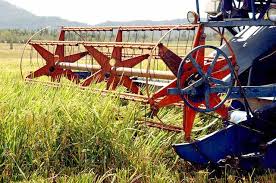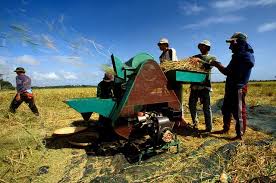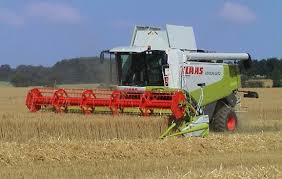Harvesting equipment is designed to handle diverse crops, some harvested above ground (e.g., cereals like wheat, sorghum, millet) and others below ground (e.g., groundnut, cassava, yam, potato).
Fruit and vegetable picking requires specialized equipment. Harvesting equipment design is based on the degree of operations involved. This article discusses various harvesting equipment for different crops.
Definition of Harvesting in Crop Production
Harvesting is the operation of cutting, picking, plucking, digging, or a combination thereof to remove crops from below or above ground or to extract useful parts or fruits from plants. Harvesting actions include:
- Slicing with a sharp tool
- Tearing with a rough serrated edge
- High-velocity single-element impact with sharp or dull edge
- Two-element scissors-type action
Harvesting can be performed using:
- Manually operated tools
- Animal-drawn machines
- Mechanically operated machines
Read Also: The Major Causes of Cannibalism among Poultry Birds
Types of Harvesting Equipment for Crops

1. Sickle: A curved steel blade with a hand grip, used manually for harvesting forage and some cereal crops, varying in shape and size based on local traditions and blacksmith practices.
The simplest device for harvesting forage and cereals, sickle design varies by region and local blacksmith practices.
2. Mower: A machine used to cut herbage crops, leaving them in a swath, adaptable for cereals like wheat, available as cutter bar or rotary mowers.
Mowers, primarily for grass, are adaptable for cereals, available as cutter bar or rotary types.
3. Reaper: A machine for cutting grain crops, available as animal-drawn, tractor-mounted, or power tiller-operated.
i. Animal-Drawn Reaper: Pulled by animals, harvesting 5–8 cm above ground, with a frame, cutter bar, knife, wheels, bearings, and attachments, requiring two operators—one guiding animals, another dropping cut crops.
ii. Tractor-Mounted Reaper: Front-mounted on tractors, lowered or raised hydraulically, powered by the tractor’s PTO, with star wheels guiding crops to the cutter bar, held vertically by springs, and conveyed sideways by a belt.
iii. Power Tiller-Operated Reaper: Similar to tractor-mounted but powered from the engine flywheel via belt or gearbox and propeller shafts, with star wheels, springs, and a conveyor belt.
4. Binder: A reaper that cuts crops and ties them into uniform sheaves.
5. Windrower: A machine that cuts crops and delivers them uniformly in a row.
6. Digger: A machine for harvesting root crops like groundnut, cassava, and potatoes.
i. Groundnut Digger: Animal-drawn or tractor-mounted, with a digging blade and spike-tooth conveyor, suitable for erect or spreading groundnut varieties in various soils.
ii. Potato Digger Elevator: A PTO-operated, single-row, tractor-mounted machine with a cutting blade and elevator roller chain, digging potatoes, shaking soil, and delivering them for manual collection.
iii. Cassava Digger Elevator: Features a wedge with side discs penetrating 300 mm, cutting through trash, lifting soil and tubers via a bar elevator that shakes out soil, delivering tubers behind the machine.
7. Combine Harvester: A sophisticated machine for large farms, performing cutting, threshing, cleaning, and bagging in one operation.
Read Also: 15 MANAGEMENT TIPS FOR BETTER POULTRY PERFORMANCE
Threshing Equipment for Post-Harvest Processing

Threshing separates grains from stalks, straw, chaff, and husks, often alongside sieving, winnowing, and sorting for packaging.
Traditionally, manual threshing with sticks is laborious, requiring many workers. Mechanized threshing reduces drudgery, improves efficiency, and minimizes losses.
1. Mechanical Thresher for Grain Separation: A machine separating grains from harvested crops, providing clean grain with minimal loss (total loss ≤5%, broken grain <2%).
The basic unit is a beater rubbing or hitting crops against a stationary plate, detaching grains by impact, rubbing, or both.
2. Components of a Thresher:
Beater (threshing cylinder) with heads or pegs, revolving for beating or rubbing.
Stationary plate (concave) with slots, against which the cylinder beats.
Feeding hopper or trough for crop input.
Winnowing device (blower fan or aspirator) to remove chaff.
Sieves to sort grains from chaff, with reciprocating motion to prevent clogging.
3. Working Principle of a Thresher: Crops are fed from the hopper into the threshing area, where grains and chaff fall onto sieves. Air from blowers or aspirators separates heavier grains, which fall through sieves, from lighter chaff, blown or sucked away.
Sieves’ motion sorts grains and prevents blockages. Threshers operate with electric motors or diesel engines, compatible with tractors, requiring 2–50 hp and 1–4 operators.
4. Adjustments for Thresher Performance: Before threshing, machines must be installed on level ground and adjusted for crop conditions, including concave clearance, sieve clearance, sieve slope, stroke length, blower suction opening, cylinder concave grate, top sieve hole size, and cylinder speeds for multi-crop threshers.
Types of Threshers and Crop Suitability
1. Drummy Type: Beaters on a shaft in a closed casing and concave.
2. Hammer Mill Type: Similar to drummy, with aspirator blower and sieve shaker.
3. Spike-Tooth Type: Spikes on a cylinder in a closed casing, with sieves and aspirator.
4. Rasp Bar Type: Corrugated bars on a cylinder with an open concave, blower, and straw walker.
5. Wire-Loop Type: Wire loops on a closed cylinder with woven wire mesh concave.
6. Axial Flow Type: Spike-tooth cylinder with woven-wire mesh concave and helical louvers.
7. Syndicator Type: Flywheel with corrugations and chopping blades in a closed casing.
Factors Affecting Thresher Performance
1. Crop Factors: Crop variety, moisture content.
2. Machine Factors: Feeding chute angle, cylinder type, diameter, spike shape, size, number, concave size, shape, clearance.
3. Operational Factors: Cylinder speed, feed rate, feeding method, machine adjustments.
Do you have any questions, suggestions, or contributions? If so, please feel free to use the comment box below to share your thoughts. We also encourage you to kindly share this information with others who might benefit from it. Since we can’t reach everyone at once, we truly appreciate your help in spreading the word. Thank you so much for your support and for sharing!

